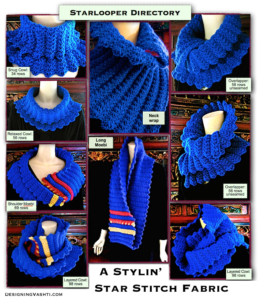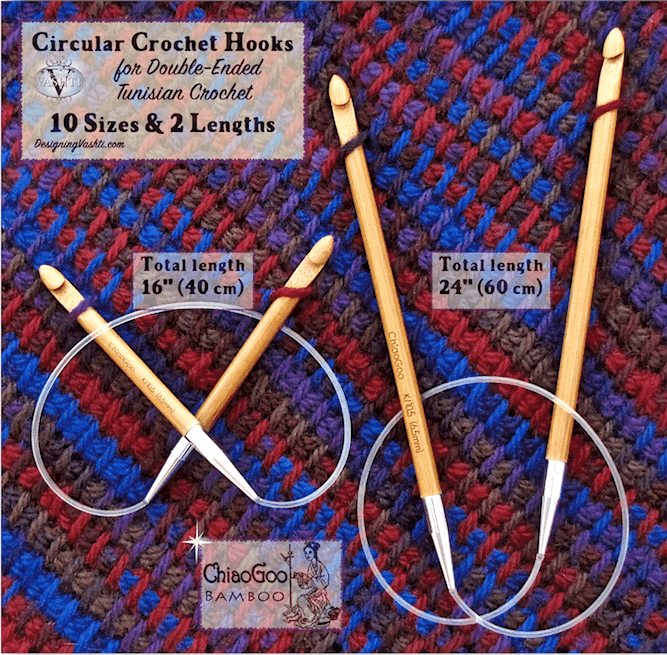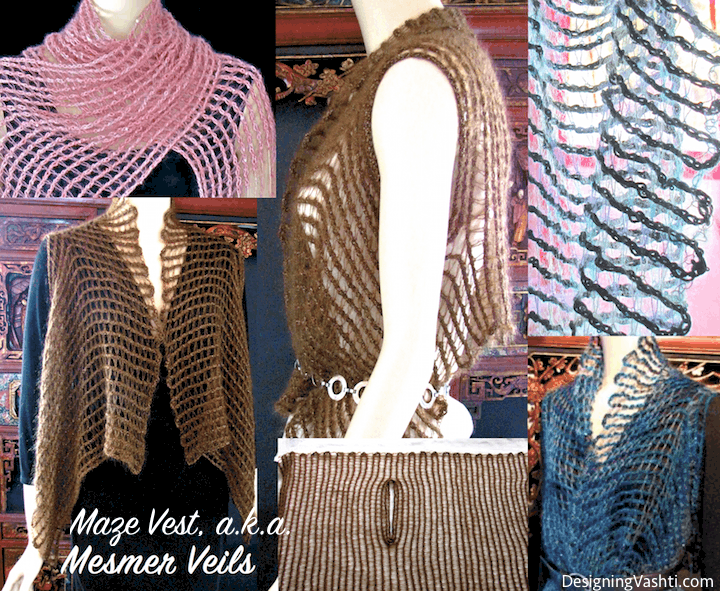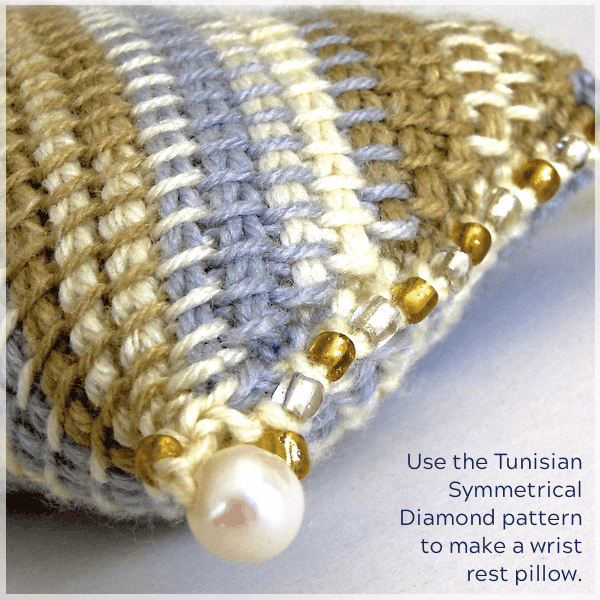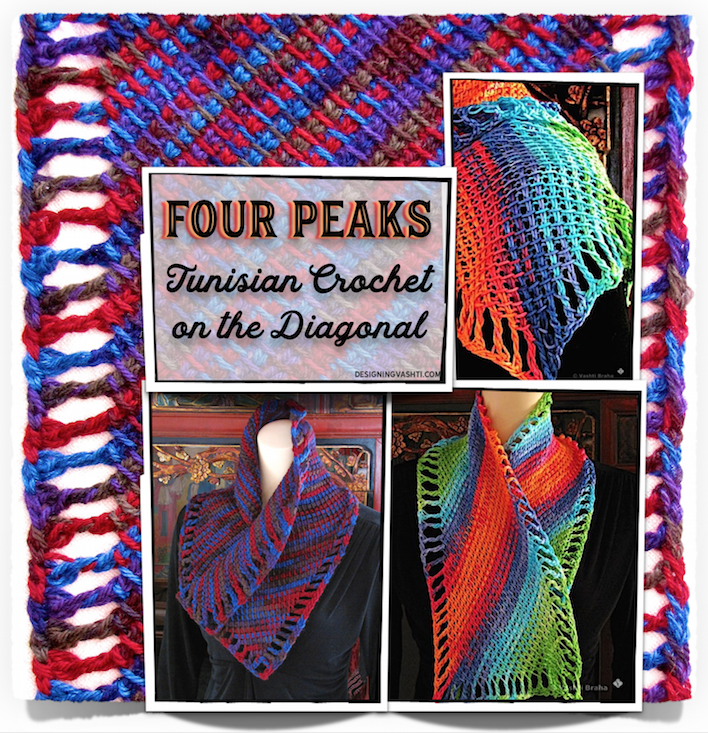This pattern set offers a unique experience of crocheting breezy Tunisian scarves, wraps, and vests. The Mesmer approach is a three-in-one introduction to:
- a versatile extended Tunisian net stitch that conserves yarn
- double-ended crocheting for a reversible and fringe-free option
- steeking (cutting open armholes with a quick snip of one stitch loop for the vest option).
An earlier version of the vest was originally published as “Maze Vest” in the Summer 2014 issue of Interweave Crochet magazine.
Like the Weightless Tunisian Stole, the Mesmer Veil directly contradicts silly old stereotypes of Tunisian crochet as being thick, stiff, and slow to crochet. Mesmer is gossamer-thin, lacy, flexible, stretchy, collapsible, and stitches up quickly. It also conserves yarn and is reversible (front and back are equally lovely). It’s simply everything Tunisian crochet isn’t thought to be.
It’s even light on the hook: only half of the stitches in a row are held on the hook, so you can make an extra-long piece without using an extra-long hook.
Although it’s a fun way to combine scrap yarns, Mesmer is designed to make expensive yarns go twice as far.
The length and width are easy to customize for creating simple wearable shapes. Use a Tunisian hook for a wrap that collapses lengthwise into a scarf with naturally fringed ends (pink version). The hand-dyed teal version is crocheted widthwise.
Use a double-ended Tunisian crochet hook to make a decorative solid edge instead of fringe.
Skill Level
Easy Intermediate (due to alternating yarns of contrasting weights and textures). You should have some experience using Tunisian crochet patterns. Use this blog post for a quick review: Five Basic Rules of Tunisian Crochet Patterns. Good examples of modern introductory-level Tunisian crochet patterns are Shaktithings, Burly, and Burly Bias.
International English equivalents for American terms are included.
?After using this pattern, you will know (if you didn’t already):
- How to create a special filet-like ethereal Tunisian net
- How to use a nonstandard Return Pass
- How to add stretch and drape to Tunisian crochet fabric
- How to combine yarns and colors that emphasize either the forward pass, or the return pass, for a unique effect.
- How to add armholes, and scarf keyholes, with truly easy steeks (cuts)
Finished Dimensions of Projects Shown
- Vest is written in standard sizes XSmall (Small, Medium, Large, XLarge). Sample shown is size Small.
- Finished bust/chest circumference: 33 (38, 42, 48, 52)”. When worn with fronts overlapped, wearing ease is approx. 4” (proportional to standard sizes) with approx. 5″ of overlap.
- Finished Back Length: 19 (20, 21, 21.5, 22)”.
- Original Mesmer Scarf (Pink) is 54” {137 cm} long (excluding 6” {15.25 cm} fringed ends) and 14” {35.5 cm} wide, measured hung after blocking. Pattern includes simple information for adding length and width to the scarf. Based on the amount of leftover yarn and projections from the Misty Wrap below, the scarf size could likely be increased to as much as 60” {152.5 cm} long and 15” {38 cm} wide without requiring an additional skein.
- Misty Mesmer Wrap (Teal) is 56” {142.25 cm} long X 22” {55.75 cm} wide.
Materials
Tunisian Crochet Hook: size K/10.5/6.5mm, 13″ {33 cm} long was used for all fringed projects shown. A double-ended Tunisian hook of the same size was used for the non-fringed projects.
Used for brown vest:
- S. Charles Collezione Luna (71% Super Kid Mohair, 20% Silk, 9% Lurex; 232yd/212.5m per .88oz/25g; CYCA #0): #41 chestnut, 1 (1, 2, 2, 2) skeins. The “thin yarn” in pattern.
- S. Charles Collezione Stella (74% Silk, 26% Lurex; 76.5yd/70m per .88oz/25g; CYCA #4): #41 chestnut, 3 (3, 4, 4, 5) skeins. The “thick yarn” in pattern.
Crochet hook for brown vest: US double-ended flexible Tunisian hook size K/10.5 (6.5mm), 13″ long. For the main pattern, a rigid double-ended hook can be used instead. A stopper for one end is needed to edge the armholes. Adjust hook size if necessary to obtain correct gauge.
Notions: Four stitch markers (m) to mark sleeves; yarn needle.
Used for Original Mesmer (Fringed Pink Scarf)
- Thicker Yarn: Tilli Tomas Disco Lights (90% Spun Silk, 10% Petite Sequins; 225yds/206m per 3.5oz/100g skein), Dusty Pink: 1 ball.
- Thinner Yarn: S.R. Kertzer Ovation (75% Kid Mohair, 25% Silk, 233yds/212m per .88oz/25g ball), color #2142, 1 ball.
Crochet hook for pink scarf: US Tunisian hook size K/10.5 (6.5mm), 13″ long. Adjust hook size if necessary to obtain correct gauge.
Yarns Used for Misty Mesmer Wrap (Teal Wrap)
- Thicker Yarn: Tilli Tomas Disco Lights (90% Spun Silk, 10% Petite Sequins; 225yds/206m per 3.5oz/100g skein), color Jade: 1 ball.
- Thinner Yarn: Blue Ridge Yarns Shadow Mini (100% brushed mohair; 225yds/205m per 45g mini skein), Blue Lagoon, 1 skein.
Crochet hook for teal stole: US double-ended Tunisian hook size K/10.5 (6.5mm), 13″ long. If you decide to add armholes later, you’ll also need a stopper for one end to edge the armholes. Adjust hook size if necessary to obtain correct gauge.
Choosing Yarns:
Mesmer’s veil quality results mainly from alternating a lace weight kid mohair yarn with a medium weight glossy sequined silk yarn. You can get other special effects by trying other very different yarns.
Part of the fun for me with this design has been combining different yarn textures, weights, and colors. Every combination I tried (except dishcloth cottons and other very plain yarns) looked great, so I hope you will be inspired to experiment.
